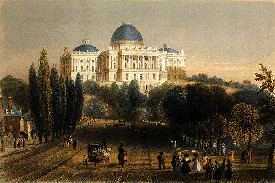The Eighteenth United States Congress was a meeting of the legislative branch of the United States federal government, consisting of the United States Senate and the United States House of Representatives. It met in Washington, D.C. from March 4, 1823, to March 4, 1825, during the seventh and eighth years of James Monroe's presidency. The apportionment of seats in the House of Representatives was based on the Fourth Census of the United States in 1820. Both chambers had a Democratic-Republican majority.
August 1823: Arikara War fought between the Arikara nation and the United States, the first American military conflict with the Plains Indians.December 2, 1823: Monroe Doctrine: President James Monroe delivered a speech to the Congress, announcing a new policy of forbidding European interference in the Americas and establishing American neutrality in future European conflicts.February 9, 1825: The House of Representatives elected John Quincy Adams as President of the United StatesJanuary 7, 1824: Tariff of 1824, Sess. 1, ch. 4, 4 Stat. 2March 3, 1825: Crimes Act of 1825, Sess. 2, ch. 65, 4 Stat. 115The count below identifies party affiliations at the beginning of the first session of this Congress, and includes members from vacancies and newly admitted states, when they were first seated. Changes resulting from subsequent replacements are shown below in the "Changes in membership" section.
President: Daniel D. Tompkins (DR)President pro tempore: John Gaillard (DR)Speaker: Henry Clay (DR)This list is arranged by chamber, then by state. Senators are listed in order of seniority, and Representatives are listed by district.
Senators were elected by the state legislatures every two years, with one-third beginning new six-year terms with each Congress. Preceding the names in the list below are Senate class numbers, which indicate the cycle of their election. In this Congress, Class 1 meant their term began in the last Congress, requiring reelection in 1826; Class 2 meant their term began with this Congress, requiring reelection in 1828; and Class 3 meant their term ended with this Congress, requiring reelection in 1824.
The names of members of the House of Representatives are preceded by their district numbers.
The count below reflects changes from the beginning of the first session of this Congress.
deaths: 3resignations: 3vacancy: 2Total seats with changes: 8deaths: 3resignations: 5contested election: 2Total seats with changes: 10Lists of committees and their party leaders.
Amendments to the Constitution (Select)Audit and Control the Contingent Expenses of the SenateBanks in Which Deposits Have Been Made (Select)ClaimsCommerce and ManufacturesDebt Imprisonment Abolition (Select)District of ColumbiaFinanceForeign RelationsIndian AffairsJudiciaryManufacturesMarquis de La Fayette (Select)Memorial of the Legislature of Arkansas (Select)Military AffairsMilitiaNational Road from Cumberland to Wheeling (Select)Naval AffairsPeale's Portrait of Washington (Select)PensionsPost Office and Post RoadsPublic LandsRoads and Canals (Select)Tariff Regulation (Select)WholeAccountsAgricultureArms Contracts (Select)Banking Memorials (Select)ClaimsCommerceDistrict of ColumbiaElectionsExpenditures in the Navy DepartmentExpenditures in the Post Office DepartmentExpenditures in the State DepartmentExpenditures in the Treasury DepartmentExpenditures in the War DepartmentExpenditures on Public BuildingsForeign AffairsIndian AffairsManufacturesMilitary AffairsNaval AffairsPensions and Revolutionary War ClaimsPost Office and Post RoadsPublic ExpendituresPublic LandsRevisal and Unfinished BusinessStandards of Official ConductWays and MeansWholeEnrolled BillsArchitect of the Capitol: Charles BulfinchLibrarian of Congress: George WatterstonChaplain: William Staughton (Baptist), elected December 10, 1823Charles P. McIlvaine (Episcopalian), elected December 14, 1824Secretary: Charles CuttsSergeant at Arms: Mountjoy BaylyChaplain: Henry B. Bascom (Methodist) elected December 1, 1823Reuben Post (Presbyterian) elected December 6, 1824Clerk: Matthew St. Clair ClarkeDoorkeeper: Benjamin BirchSergeant at Arms: Thomas Dunn, elected December 1, 1823, diedJohn O. Dunn, elected December 6, 1824 
